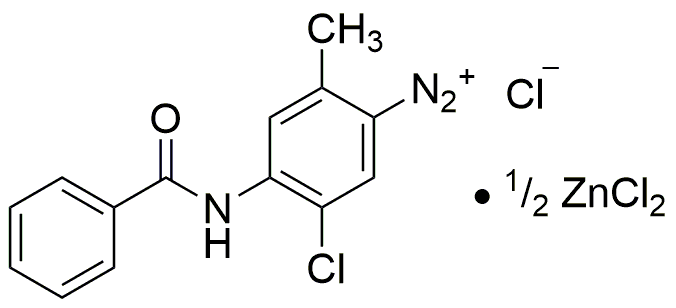Fast Red Violet LB Salt is widely utilized in research focused on:
- Histology and Cytology: This compound is commonly used as a dye in histological staining procedures, allowing researchers to visualize cellular structures and tissue samples under a microscope.
- Immunohistochemistry: It serves as a chromogen for enzyme-linked immunohistochemical staining, enhancing the detection of specific proteins in tissue sections, which is crucial for cancer diagnostics.
- Textile Industry: Fast Red Violet LB Salt is applied in dyeing processes, providing vibrant colors to fabrics while maintaining excellent lightfastness and washfastness, making it ideal for high-quality textiles.
- Food Industry: This chemical can be used as a food coloring agent, contributing to the aesthetic appeal of various food products while complying with safety regulations.
- Research and Development: It plays a role in developing new staining techniques and methodologies in laboratories, helping scientists innovate and improve existing protocols.
General Information
Properties
Safety and Regulations
Applications
Fast Red Violet LB Salt is widely utilized in research focused on:
- Histology and Cytology: This compound is commonly used as a dye in histological staining procedures, allowing researchers to visualize cellular structures and tissue samples under a microscope.
- Immunohistochemistry: It serves as a chromogen for enzyme-linked immunohistochemical staining, enhancing the detection of specific proteins in tissue sections, which is crucial for cancer diagnostics.
- Textile Industry: Fast Red Violet LB Salt is applied in dyeing processes, providing vibrant colors to fabrics while maintaining excellent lightfastness and washfastness, making it ideal for high-quality textiles.
- Food Industry: This chemical can be used as a food coloring agent, contributing to the aesthetic appeal of various food products while complying with safety regulations.
- Research and Development: It plays a role in developing new staining techniques and methodologies in laboratories, helping scientists innovate and improve existing protocols.
Documents
Safety Data Sheets (SDS)
The SDS provides comprehensive safety information on handling, storage, and disposal of the product.
Product Specification (PS)
The PS provides a comprehensive breakdown of the product’s properties, including chemical composition, physical state, purity, and storage requirements. It also details acceptable quality ranges and the product's intended applications.
Certificates of Analysis (COA)
Search for Certificates of Analysis (COA) by entering the products Lot Number. Lot and Batch Numbers can be found on a product’s label following the words ‘Lot’ or ‘Batch’.
*Catalog Number
*Lot Number
Certificates Of Origin (COO)
This COO confirms the country where the product was manufactured, and also details the materials and components used in it and whether it is derived from natural, synthetic, or other specific sources. This certificate may be required for customs, trade, and regulatory compliance.
*Catalog Number
*Lot Number
Safety Data Sheets (SDS)
The SDS provides comprehensive safety information on handling, storage, and disposal of the product.
DownloadProduct Specification (PS)
The PS provides a comprehensive breakdown of the product’s properties, including chemical composition, physical state, purity, and storage requirements. It also details acceptable quality ranges and the product's intended applications.
DownloadCertificates of Analysis (COA)
Search for Certificates of Analysis (COA) by entering the products Lot Number. Lot and Batch Numbers can be found on a product’s label following the words ‘Lot’ or ‘Batch’.
*Catalog Number
*Lot Number
Certificates Of Origin (COO)
This COO confirms the country where the product was manufactured, and also details the materials and components used in it and whether it is derived from natural, synthetic, or other specific sources. This certificate may be required for customs, trade, and regulatory compliance.


